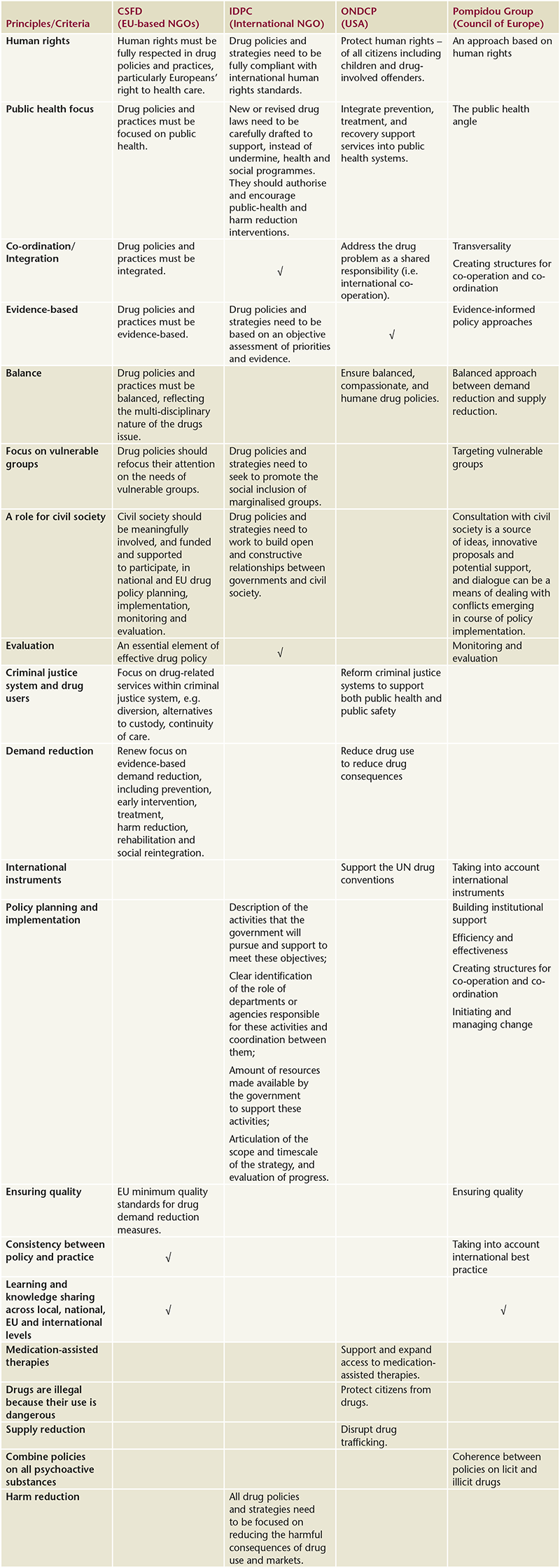Pike, Brigid
(2013)
What makes for a ‘good’ drugs policy?
Drugnet Ireland,
Issue 44, Winter 2012,
pp. 11-13.
In recent months a slew of documents outlining what makes for a ‘good’ drugs policy have appeared. Two sets of guidelines have emanated from the NGO sector, at EU and international level, and two from governmental sources – the Council of Europe and the US government. A study of the principles and criteria as summarised in the table below highlights the differing perspectives and priorities of the different entities.
Just two principles are explicitly mentioned in all four guidelines – the need both to recognise human rights and to focus on public health. Two other principles are referred to either explicitly or implicitly in all four documents – the need for a co-ordinated or integrated response, and the need for evidence-based policy. However, the interpretation of these terms varies. For example, the EU’s Civil Society Forum on Drugs (CSFD) emphasises the ‘right to health care’ of all EU citizens, while the US government policy guidelines foreground the need to protect the ‘human rights of all citizens’, including children and drug users.
The omission of certain principles from various guidelines is also instructive. All guideline documents, except for those published by the White House’s Office of National Drug Control Policy (ONDCP), highlight the need to focus on vulnerable groups and to promote their social inclusion, as a preventive measure. Both sets of guidelines published by governmental sources call for compliance with international treaties, while neither set of guidelines issued by NGO bodies refer to international policy instruments. Both sets of NGO policy guidelines call for a full role for civil society in developing and implementing drug policy. On the other hand, the Council of Europe’s policy guidelines recommend a limited role for civil society – consultation in order to tap into the experience, and dialogue as a means of containing conflict; the US government’s policy guidelines do not identify any role for civil society.
Finally, principles put forward by one organisation and not mentioned by others tend to emphasise that organisation’s priorities. Thus:
· International Drug Policy Consortium: the principle of harm reduction to be applied not only when addressing drug use but also when tackling drug markets;
· Office of National Drug Control Policy: ensuring access to medication-assisted therapies, protecting citizens from drugs and disrupting drug trafficking reflect the US government’s twin emphases on public health and public safety; and
· Pompidou Group: coherence between policies on illegal and legal psychoactive substances, and other forms of addiction and dependency, reflect a recognition of growing polydrug use and findings from addiction research and neurobiology, which indicate that substance abuse and other addictions are inter-related.

*Key:
√ = principle/criteria implicit in the document
= principle/criteria neither specified nor implied
Sources:
CSFD (Civil Society Forum on Drugs) (April 2012) ‘General principles for drug policies’ in
Proposal to the EU member states and the European Commission for inclusion in the new EU drugs strategy and action plan. Available at
www.drugsandalcohol.ie/18220IDPC (International Drug Policy Consortium) (March 2012) ‘Chapter 1: Core principles for developing effective drug policy’, in
Drug policy guide. 2nd edition. Accessed 25 May 2012 at
www.idpc.net